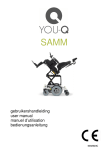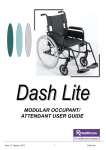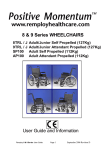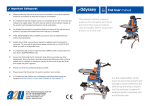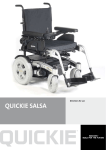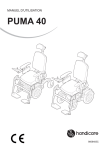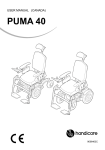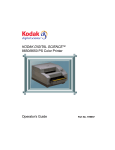Download GENERAL USER MANUAL
Transcript
GENERAL USER MANUAL ALEX 9002988A 2 English © 2009 Handicare All rights reserved. The information provided herein may not be reproduced and/or published in any form, by print, photoprint, microfilm or any other means whatsoever (electronically or mechanically) without the prior written authorisation of Handicare. The information provided is based on general data concerning the constructions known at the time of the publication of this manual. Handicare executes a policy of continuous improvement and reserves the right to changes and modifications. The information provided is valid for the product in its standard version. Handicare cannot be held liable for possible damage resulting from specifications of the product deviating from the standard configuration. The available information has been prepared with all possible diligence, but Handicare cannot be held liable for possible errors in the information or the consequences thereof. Handicare accepts no liability for loss resulting from work executed by third parties. Names, trade names, etc. used by Handicare may not, as per the legislation concerning the protection of trade names, be considered as being available. 2009-01 3 Table of content Foreword .......................................................................................................................6 1 Safety .....................................................................................................................7 1.1 Temperature ...................................................................................................7 1.2 Moving parts ...................................................................................................7 1.3 Electromagnetic radiation................................................................................8 1.4 Decals and instructions on the wheelchair ......................................................8 1.4.1 Used decals on the wheelchair ...............................................................9 2 General description of the wheelchair ..............................................................10 2.1 Configurations...............................................................................................10 2.2 The user........................................................................................................11 2.3 User environment..........................................................................................11 2.4 Adjustment options .......................................................................................12 3 Wheelchair settings ............................................................................................13 4 Checking the wheelchair before putting into use ............................................14 5 Use of the wheelchair .........................................................................................15 5.1 Getting in and out of the wheelchair..............................................................15 5.1.1 Forwards transfer ..................................................................................15 5.1.2 Sideways transfer..................................................................................15 5.2 Driving the wheelchair...................................................................................16 5.2.1 Curves...................................................................................................16 5.2.2 Braking/Emergency stop .......................................................................16 5.3 Driving on a slope .........................................................................................16 5.3.1 Slopes steeper than the normal user environment................................16 5.4 Obstacles ......................................................................................................17 5.4.1 Driving up a kerb ...................................................................................17 5.4.2 Driving down a kerb ..............................................................................17 5.5 Adjustment options .......................................................................................18 5.6 Freewheel switch: pushing the wheelchair....................................................18 5.7 Storage after use ..........................................................................................19 6 Transport of the wheelchair ...............................................................................20 6.1 Transport of the wheelchair...........................................................................20 6.2 Reducing the wheelchair...............................................................................20 6.2.1 Removing the seat ................................................................................21 6.2.2 Removing the legrests ..........................................................................21 6.2.3 Removing the armrests .........................................................................21 6.2.4 Folding down the backrest ....................................................................21 7 Maintenance of the wheelchair ..........................................................................22 7.1 Cleaning the wheelchair................................................................................22 7.1.1 Removing dry dirt ..................................................................................22 7.2 Batteries........................................................................................................22 7.2.1 Charging the batteries...........................................................................23 7.2.2 Maintaining the batteries .......................................................................23 7.2.3 Replacing the batteries .........................................................................23 7.3 Tyres .............................................................................................................23 7.3.1 Tyre repair of drive wheels ....................................................................24 7.4 Discarding the wheelchair .............................................................................24 7.4.1 The environment ...................................................................................24 8 Warranty ..............................................................................................................25 9 Technical specifications ....................................................................................27 4 Table of content 9.1 INDOOR/Outdoor..........................................................................................28 9.2 OUTDOOR/indoor.........................................................................................29 9.3 Electric wiring diagram ..................................................................................30 5 Foreword Foreword This user manual The user manual for this electric wheelchair consists of three booklets. Read the entire user manual carefully before taking the product into use. The information provided by this manual is essential for the safe use and proper care (cleaning) of the wheelchair. • The general user manual (this booklet) • The user manual for the seating system (Sedeo) • The user manual for the controller If one of these user manuals was not included with your wheelchair, please contact your dealer immediately. In addition to this user manual, there is also a service manual for qualified specialists. This general user manual will refer, where necessary, to one of the other user manuals. This is indicated as follows: GENERAL CONTROLLER: Refers to the user manual for the controllers. SEDEO: Refers to the user manual for the seating system. Symbols used in this manual Warning symbol Follow the instructions next to this symbol closely. Not paying careful attention to these instructions could result in physical injury or damage to the wheelchair or the environment. Reference symbol The symbol refers to a separate user manual. This reference will indicate the specific user manual and the section to which is being referred. 6 Safety 1 Safety Safety information is indicated with the warning symbol. • 1.1 Follow the instructions carefully next to these warning symbols! Not paying careful attention to these instructions could result in physical injury or damage to the wheelchair or the environment. Wherever possible, safety information is provided in the relevant chapter. Temperature Temperature • • 1.2 Avoid physical contact with the wheelchair’s motors at all times. Motors are continuously in motion during use and can reach high temperatures. After use, the motors will cool down slowly. Physical contact could cause burns. If you do not use the wheelchair, ensure that it is not exposed to direct sunlight for lengthy periods of time. Certain parts of the wheelchair, such as the seat, the back and the armrests can become hot if they have been exposed to full sunlight for too long. This may cause burns or allergic reactions to the skin. Moving parts Moving parts Figure 1.1 • A wheelchair has moving and rotating parts. Contact with moving parts may result in serious physical injury or damage to the wheelchair. Contact with the moving parts of the wheelchair should be avoided. • Wheels (turning and castor) • Electric tilt in space adjustment • Electric high/low option • Electric backrest adjustment • Swing-away controller holder 7 Safety 1.3 Electromagnetic radiation Electromagnetic radiation The standard version of your electric wheelchair has been tested on the applicable requirements with respect to electromagnetic radiation (EMC requirements) In spite of these tests: • it cannot be excluded that electromagnetic radiation may have an influence on the wheelchair. For example: • mobile telephony • large-scale medical apparatus • other sources of electromagnetic radiation • it cannot be excluded that the wheelchair may interfere with electromagnetic fields. For example: • shop doors • burglar alarm systems in shops • garage door openers In the unlikely event that such problems do occur, we request that you notify your dealer immediately. 1.4 Decals and instructions on the wheelchair Decals and instructions on the wheelchair • The signs, symbols and instructions affixed to the wheelchair comprise part of the safety facilities. They must never be covered or removed. They must remain present and clearly legible throughout the entire lifespan of the wheelchair. • Replace or repair all illegible or damaged signs, symbols and instructions immediately. Please contact your dealer for assistance. 8 Safety 1.4.1 Used decals on the wheelchair Check manual before using Freewheel switch in ‘Drive’ mode Freewheel switch in ‘Push’ mode. Don’t put the freewheel switch in ‘Push’ mode on a slope Battery charging connection Attachment point of the tie-down system for transportation in a vehicle. Danger of crushing! Use caution when swinging the controller aside to avoid getting anything crushed. Trap danger. Danger of getting fingers jammed Identification plate A B C D E Model Year of manufacture Identification number Usage is indoors and outdoors Maximum load in kg 9 General description of the wheelchair 2 General description of the wheelchair Comfort is of paramount importance to many people who make use of a wheelchair. And this is exactly what this electrical driven wheelchair offers: an unknown degree of driving comfort. A distinctive feature is the unique independent suspension system, which absorbs not only shocks, but also vibrations. CE declaration The product is in conformity with the provisions of the Medical Devices Directive and thus has CE marking. Figure 2.1: left front wheel driven (FWD), right rear wheel driven (RWD) Main components basic model A. Drive wheels B. Castor wheels C. Free wheel switch D. Controller 2.1 Seating system E. Seat F. Backrest G. Armrest H. Legrest with foot support I. Headrest Configurations Generally speaking, the Alex is comprised of an undercarriage with a seating system on top. This special undercarriage makes it possible for you to configure Alex as a front wheel or rear wheel-driven wheelchair (FWD or respectively RWD). The Alex is available in a range of different speeds up to a maximum of 12.5 km/hr. In addition, the Alex can be executed with two different kinds of tyres (indoors and outdoors). This will have an effect on certain specifications. To make this easier for our 10 General description of the wheelchair customers, we have made a distinction between the Alex ‘type INDOOR / outdoor and an Alex ‘type OUTDOOR / indoor’. • • • 2.2 The technical specifications may not be changed. Do not make any changes to the electrical circuit. Any modifications to the wheelchair or any parts thereof are not permitted. The user Driving an electric wheelchair requires cognitive, physical and visual skills. The user must be able to estimate and correct the results of actions when operating the wheelchair. The wheelchair can not transport more than 1 person at a time. The maximum user weight is 160 kg. unless otherwise indicated on the identification plate. Additional weight, such as rucksacks, accessories or medical apparatus must be added to the user’s weight to determine the maximum weight, which cannot be exceeded. The user must be informed of the contents of this user manual before driving the wheelchair. In addition, the user of the wheelchair must be given thorough instruction by a qualified specialist before he or she participates in traffic. The first sessions in the wheelchair should be practiced under supervision of a trainer/advisor. • • • • • 2.3 The user of the wheelchair is at all times completely responsible for complying with the applicable local safety regulations and guidelines. If you are under the influence of medicines that can have an effect on your ability to drive, you are not permitted to drive a wheelchair. Adequate vision is required in order to safely operate a wheelchair in the user situation concerned. Not more than one person at a time can be seated in the wheelchair. Do not allow children to ride in the wheelchair unsupervised. User environment This wheelchair has been designed to accommodate both indoor and outdoor use (EN12184 class B). When driving the wheelchair outdoors, drive only on paved roads, pavements, footpaths and bicycle paths. The speed must be adapted to suit the environment. With all adjustment options set to neutral (table 2.1), it can be assumed that when using an RWD Alex, a slope of ≤10˚ belongs to a normal user environment with no danger of instability. In an FWD Alex this is ≤6˚. In the technical specifications, you will find this under ‘maximum safe slope’. • • • Drive carefully on slippery roads resulting from rain, ice or snow! Prevent the wheelchair from coming into contact with sea water: sea water is caustic and may damage the wheelchair. Prevent the wheelchair from coming into contact with sand: sand can permeate into 11 General description of the wheelchair • • • • • • • • 2.4 the moving parts of the wheelchair, causing extensive wear on these parts. You are required to turn on the lights in case of limited visibility. When driving at higher speeds you must be extra careful. Select a lower maximum speed indoors, on the pavement and in pedestrian areas. Do not drive off high obstacles. Do not use the wheelchair if temperatures are below: -10˚C or above +50˚C. Do not attach a weight to the wheelchair without the approval of a qualified specialist. This may negatively affect the stability of the product. Do not push and/or tow any objects with the wheelchair. Do not open doors using the legrests. Do not drive through puddles of water. Adjustment options The Alex is available with the following electrical and/or mechanical adjustment options: Adjustment option Electrically adjustable tilt in space option Electrically adjustable high/low option Electrically adjustable backrest option Electrically or mechanically adjustable legrests Neutral position The entire chair upright The chair in the lowest position The backrest as upright as possible The legrests are positioned as closely as possible to the chair. Table 2.1: electrical adjustment options and the neutral position Figure 2.2: Electrical adjustment options • • 12 Use of the electrical adjustment options may influence the centre point of gravity. These adjustments should only be made when the wheelchair is stationed on a flat surface. Electrical adjustment options are linked to moving and/or rotating parts. Contact with these moving parts may result in serious physical injury or damage to the wheelchair. Contact with the moving parts of the wheelchair must be avoided. Wheelchair settings 3 Wheelchair settings The average wheelchair user does not exist. This is why Handicare wheelchairs can be adjusted according to the specific needs of the user. In this, we make a distinction between wheelchair settings and wheelchair adjustment options. Settings are carried out only once and must be executed by qualified specialists, unless explicitly stated otherwise. Adjustment options can be carried out by the user. These adjustment options do not require the use of tools. Only to be carried out by qualified specialists Adjusting the seating system The extensive settings with respect to the seating system allow for optimum support of the body. The following setting options are possible: Seating system SEDEO • Depth, width of the seat • Backrest angle • Armrest height • Lower leg length • Angle of the footplate Seat angle, Seat height Depending on the specific circumstances of the user of the wheelchair the seat height can be set. Every optional seat height lays within the 6˚ (10.5%) maximum safe slope of according to EN12184 ClassB. Lowering the seat height has a positive influence on the (dynamic) stability. Seat height setting Enlarging the seat height has a negative influence on the (dynamic) stability, because the centre point of gravity gets higher. Seat position and centre point of gravity setting The seat position and centre point of gravity can be adjusted. For this purpose there are 3 positions in the seat slide (figure 3.1). The wheelchair is designed and tested to be used in the standard position (middle hole). Only change the seat position and centre point of gravity to compensate specific user circumstances. For example: when a user has no legs. Seat position and centre point of gravity setting Changing the seat position and centre point of gravity: • Will have a negative influence on the driving characteristics of the wheelchair if used wrong. • Will have a negative influence on the (dynamic) stability of the wheelchair if used wrong. • In case of doubt contact Handicare technical support for advise. 13 Checking the wheelchair before putting into use Figure 3.1: Seat position and centre point of gravity setting Height and depth of the controller SEDEO Programme of the control system • Only to be carried out by qualified specialists. Incorrect setting of the parameters of the control system could lead to very dangerous situations. 4 Checking the wheelchair before putting into use Be careful! Check the following before driving: • Are the tyres sufficiently inflated (Ch. 7.1) • Are the batteries sufficiently charged? The green lights on the battery indicator must be on. CONTROLLER • Are the lights on the direction indicators functioning properly? CONTROLLER Ensure that the free wheel switch has been set to ‘drive’. • • 14 When operating the wheelchair, ensure that your clothing does not hamper the wheelchair (i.e. too long). Before use, always check if your clothing or accessories do not come into contact with the wheels or and other moving and/or rotating parts in which they could become entangled. In winter, batteries have a reduced capacity. During a period of light frost, the capacity is roughly 75% of the normal capacity. At temperatures below -5˚C this will be roughly 50%. This will reduce your range of action. Use of the wheelchair 5 Use of the wheelchair 5.1 Getting in and out of the wheelchair Getting in and out of a wheelchair is sometimes called making a transfer. Be careful! Before a transfer is made, ensure that: • The controller has been switched off • That the freewheel switch has been switched to ‘drive’ (ch. 5.6) • Do not stand on the foot-plates. These have not been designed to accommodate the full weight of a person. In addition, this could cause the wheelchair to topple over. 5.1.1 1. 2. 3. 4. Forwards transfer Fold up the foot supports Swing the calf plates to the side (if applicable) If possible, swing the legrests to the side Seat yourself in the chair 5.1.2 Sideways transfer 1. Unscrew the cap and remove the armrest 2. Seat yourself in the chair Figure 5.1 15 Use of the wheelchair 5.2 • • • Driving the wheelchair As a wheelchair user, you are vulnerable in traffic. Keep in mind that other participants in traffic may not always notice you. Keep to the applicable traffic regulations. Avoid out-of-the-way routes so that help can be quickly on its way when needed. Adapt your driving style and speed to the circumstances Electric wheelchairs are driven by means of a controller. The controller has its own user manual CONTROLLER, which has been included with this wheelchair. Switch on the controller CONTROLLER Set the maximum speed limit CONTROLLER Move the joystick into the direction you would like to go Moving the joystick even further forwards will cause the wheelchair to move faster • • • • 5.2.1 Curves Never take curves at full speed. Decrease your speed before taking a curve. Use the indicators when changing direction. • • 5.2.2 Braking/Emergency stop To brake, the joystick must be moved into the neutral position or released completely. The wheelchair will brake automatically. An emergency stop can also be made by releasing the joystick. An emergency stop can be made by releasing the joystick. The following should be avoided when driving: • Do not push the on/off button • Do not move suddenly in the opposite direction The wheelchair will come to an abrupt standstill with a sudden jolt. Not only is this uncomfortable, it could lead to tipping over if you are on a slope. 5.3 Driving on a slope With all adjustment options set to the neutral position (table 2.1), it can be assumed that when using an RWD Alex, a grade of ≤10˚ (17.6%) belongs to a normal user environment with no danger of instability. In an FWD Alex this is ≤6˚ (10.5%). In the technical specifications, you will find this under ‘maximum safe slope’. 5.3.1 Slopes steeper than the normal user environment Driving on slopes whose grade is steeper than the maximum safety limit can lead to safety risks with respect to stability. This requires great care and complete control of the user. Always drive carefully and never take unnecessary risks! Follow the instructions next to the warnings carefully! 16 Use of the wheelchair The stability and performance of a wheelchair depend on a number of variables. Wheelchairs are adapted according to the needs of individual users. This is why variables will differ from wheelchair to wheelchair. Ask your dealer to inform you about the instructions for use and the specific settings and adjustments that can influence the driving characteristics of the wheelchair. Driving on a slope Driving on a slope • When driving on a slope, always drive carefully and with the utmost concentration. • Avoid sudden and jerky movements. • Avoid making emergency stops on a slope. • Avoid changing direction on a slope whenever possible. • Do not turn on a slope. • Only drive up a slope with all the adjustment options set to the neutral position. • Driving on a slope in reverse can be extremely dangerous. • Do not drive on slopes with loose gravel or a sandy surface, as one of the driving wheels could slip/spin. • Driving on a slope too long can cause overheating of the motor. • When driving down a slope forwards in a FWD wheelchair, we always recommend using an anti-tip. Uphill • If you notice a strong decrease in speed when driving up a slope, take a less steep route. Downhill • Prevent the wheelchair from gaining too much speed. 5.4 Obstacles 5.4.1 • • • • Choose the place where the kerb is at its lowest (see chapter 11 ‘climbing capacity for obstacles’) Drive straight up to the kerb (20 cm in front of the kerb). Move the joystick forwards. Drive up the kerb without changing direction. As soon as the front wheels are on the pavement, you must maintain speed in order to get onto the pavement with all wheels. If it is impossible to drive onto the pavement, find a lower place where it is possible. 5.4.2 • • • Driving up a kerb Driving down a kerb Choose the place where the kerb is at its lowest. In case of doubt, do not take any risks and find another route or someone to help you. Drive with your front wheels straight up to the kerb. Move the joystick slowly forwards. Drive down the kerb carefully and as slowly as possible, without changing direction. 17 Use of the wheelchair • • 5.5 Never drive down stairs in a wheelchair. Do not drive off obstacles higher than 6 cm. Adjustment options Adjustment options are those parts of a wheelchair that can be adjusted by the user without the use of tools. The Alex can be ordered with the following adjustment options: Mechanical adjustment options • Comfort legrests SEDEO • Swing-away joystick holder SEDEO • Headrest SEDEO Electrical adjustment options • Electrical tilt adjustment CONTROLLER • Electrical high/low option CONTROLLER • Electrical backrest adjustment CONTROLLER • Electrical legrests CONTROLLER Figure 8.2 5.6 Freewheel switch: pushing the wheelchair The wheelchair can also be moved by pushing. For this purpose, the motors must be disengaged. This is done with a freewheel switch; one for each motor. Figure 5.1: Links: free wheel switch in ‘push’ position; Right: ‘drive’ position 18 Use of the wheelchair The freewheel switch can be set to two positions: ‘Drive’ mode. In this position, the chair can not be pushed. ‘Push’ mode. In this position, the chair can not be driven using the controller. • • The automatic parking brake only works if the switch is set to the ‘drive’ position. The freewheel switch should only be set to ‘push’ if the chair is to be pushed. When the chair is no longer being pushed, the freewheel switch should be set to 'drive' immediately. • • 5.7 The freewheel switch is a function that was developed especially for wheelchair attendants. The freewheel switch should only be operated by the attendant and never by the user. Never set the switch to ‘push’ on a slope! When the freewheel switch is set to ‘push’, the automatic parking brake will be deactivated. The wheelchair could then move down the slope. Storage after use If the wheelchair is not in use, it must be stored in a cool place without being exposed to extreme weather conditions. Do not place the wheelchair in direct sunlight. Parts of the wheelchair can become so hot that they could cause burns. The surrounding temperature when stored may not be lower than 20˚C or higher than +65˚C. 19 Transport of the wheelchair 6 Transport of the wheelchair A wheelchair is not designed as a car seat and cannot offer the same degree of safety that is offered by standard car seats, no matter how securely it has been fastened in the vehicle concerned. Handicare recommends that wheelchair users transfer to a regular car seat if possible. • • • Position the wheelchair in the car never in a other way than facing front wards. Use an ISO 10542 approved attachment system suitable for the for the total weight of the wheelchair to secure the wheelchair. The wheelchair can only be fastened by securing it to the tie-down points on the wheelchair’s frame. The wheelchair may not be secured onto any accessories (wishbones, armrests, anti-tip brackets etc.). It may not be possible for every wheelchair user to transfer. • Always ask for confirmation of the transporter that the vehicle is suitably designed, insured and equipped to transport a person in a wheelchair. • Handicare recommends that the wheelchair be equipped with a headrest and that this is used during transportation. • During transportation, it is essential that you are secured with a three-point safety belt that is attached to the floor and a side of the vehicle. • A lapstrap attached to the wheelchair only serves to keep the person in an upright position and cannot be considered on par with a car safety belt. 6.1 Transport of the wheelchair Electric wheelchairs are very heavy to lift. Use suitable ramps to wheel the chair in and out of the vehicle. Once the wheelchair is in the vehicle, it must be secured with an ISO 10542 approved tie-down system that is suited to the weight of that particular wheelchair. The weight of the wheelchair depends on its composition. The technical specifications (Ch. 9) give insight in several optional items and how they influence the total weight. Always weigh the total weight of the wheelchair to be certain that the correct fastening system is used. 6.2 Reducing the wheelchair For transporting the wheelchair without an occupant. Parts of the wheelchair that can easily be detached should be removed from the wheelchair. Store these parts securely. If the loading space of the car concerned is small, the back can also be folded back. 20 Transport of the wheelchair Figure 6.1 6.2.1 Removing the seat 1. Pull up the seat in front. When replacing the seat, the clips (B in figure 6.1) must click around the round bar in the frame. Check if the seat has been clicked into place securely. 6.2.2 Removing the legrests 1. Push the catch backward to unlock the legrest. 2. Swing the legrest outward. 3. Raise the legrest and remove it from the legrest holder. When the legrest is returned to its original position, you should hear a click. Only then can you be certain that the legrest is securely locked in place. 6.2.3 Removing the armrests 1. Unscrew the cap and remove the armrest. If the wheelchair has been equipped with lights, disconnect the lighting plug. The controller will remain connected to the wheelchair by its wiring. 6.2.4 Folding down the backrest 1. Flip the lock clip (C in figure 6.1) off the adjusting bar (D in figure 6.1). 2. Pull the lock clip out of the hinged joint. 3. Fold down the backrest. 21 Maintenance of the wheelchair 7 Maintenance of the wheelchair For information concerning specific settings, maintenance or repair work, please contact your dealer (dealer contact details on the back cover). Make sure you always mention the model, year of manufacture and identification number. This information is provided on the identification plate of the product. We recommend having the wheelchair serviced by your dealer once a year, or in case of intensive use, every six months. Time Daily Weekly Monthly Annually Description of maintenance by user Charge the batteries after each use (See chapter batteries) Check the tyre pressure and inflate the tyres if necessary (See chapter tyres) Clean the wheelchair (See chapter cleaning the wheelchair) Contact dealer for service by the dealer Table 7.1: maintenance by the user 7.1 Cleaning the wheelchair To clean the seating system, we refer to the user manual for the seating system SEDEO. • • Ensure that the controller is switched off during cleaning. If the joystick is accidently touched, the wheelchair can move and the electrical options used accidentally. Be careful with water in view of the electronic system 7.1.1 Removing dry dirt First, wipe the dirty parts with a wet sponge. Use preferably clean water or soft soapy water. Wipe the parts dry with a soft dry cloth. Never use abrasive or aggressive cleaning agents. They can scratch the wheelchair. Do not use organic solvents such as thinner, benzene or white spirit. 7.2 Batteries The wheelchair uses ‘dry’ gel batteries. These batteries are completely closed and maintenance free. • • 22 The use of ‘wet’ batteries is not permitted. In winter, batteries have a reduced capacity. During a period of light frost, the capacity is roughly 75% of the normal capacity. At temperatures below -5˚C this will be roughly 50%. This will reduce your range of action. Maintenance of the wheelchair 7.2.1 Charging the batteries Consult the user manual of the battery charger to determine if this is suitable for the batteries in use. For technical specifications see chapter 9. Charging the batteries First, switch off the wheelchair’s controller. Put the charge plug of the battery charger in the charge connector of the controller • • CONTROLLER Activate the battery charger. This depends on the type of battery charger. Consult the user manual of your battery charger. • If the wheelchair is not being used, we recommend charging the batteries via the battery charger. For normal use, the batteries should be charged every night. The battery charger’s display will indicate when the batteries have been fully charged. Depending on how depleted the batteries are, it may take up to 12 hours before the batteries are once again fully charged. 7.2.2 Maintaining the batteries Ensure that the batteries are always fully charged. Not using the batteries for a long period of time can damage them. Do not use the wheelchair if the batteries are almost depleted and never completely deplete the batteries. This can seriously damage the batteries and you may run the risk of coming to an unintended standstill. • • 7.2.3 Replacing the batteries If the capacity of the batteries is continually decreasing so that the wheelchair can only be used for short trips, this will mean that the batteries are the end of their lifespan. The batteries will then need to be replaced. Please contact your dealer for assistance. • 7.3 Batteries contain acids. Damaged batteries can cause severe danger to your health. Follow the instructions on the batteries at all times. Tyres To ensure that your wheelchair functions properly, it essential that the tyres are kept at the correct pressure. The maximum pressure can be found on the tyre and table 7.1. Alex INDOOR / outdoor Maximum Tyre pressure (Bar) Drive Wheel 2.8 Castor Wheel 3.5 Alex OUTDOOR / indoor Drive Wheel 2.1 Drive Wheel 3.5 Table 7.1: Tyre pressure 23 Maintenance of the wheelchair Tyres that are too soft will have a negative effect on the wheelchair’s performance. It will also cost more energy to move the wheelchair forward and this will also cause the batteries to be depleted faster. Furthermore, wear on the tyres when driving with soft tyres is unnecessarily high. Never exceed the maximum tyre pressure (Table 7.1). 7.3.1 Tyre repair of drive wheels Only to be carried out by qualified specialists • Tyres should only be replaced by a qualified specialist. For an extensive description of tyre repairs we would like to refer you to the service manual available to qualified specialists. Before tyres are repaired they must first be completely deflated. 7.4 Discarding the wheelchair The lifespan of a wheelchair is influenced by the extent to which it is maintained. To be able to take maximum advantage of the lifespan of your wheelchair we recommend regular maintenance (see chapter maintenance). 7.4.1 The environment If your wheelchair has come to be superfluous or needs to be replaced, it can usually be taken back by your dealer in consultation. If this is not possible, please ask your local authority about the possibilities of recycling or environmentally friendly disposal of the materials. In the production of a wheelchair, many different plastics and materials are incorporated. Furthermore, the wheelchair is comprised of various electronic components that should be disposed of as electronic waste. The batteries should be put in the chemical waste bin. No environmental contribution for eventual recycling applies to wheelchairs. 24 Warranty 8 Warranty In the following warranty and liability stipulations the terms and definitions as summed up hereafter must be explained as follows: • Product: The hand-operated or electric wheelchair or scooter manufactured and delivered by Handicare. • Customer: The person who directly obtains a Product from Handicare. • Dealer: The person who delivers a Product obtained from Handicare to customers or third parties. • User: The person who uses a Product manufactured by Handicare. Irrespective of what is determined concerning warranty conditions applicable to the Product, in any case the following applies with regard to the warranty: 1. Except insofar as described otherwise Handicare guarantees the Product for its suitability for the purpose for which the Product is intended - all of these points as described in this manual - and for the quality of the material of which the Product is made and the manner in which the Product is manufactured. 2. Repairs or replacement of parts of the Product that may be necessary as a result of faults that are based on qualitatively faulty material or manufacturing errors will be executed free of charge, as long as such faults occurred within one (1) year after the date of delivery of the Product to the Customer. The parts to be replaced must be shipped post-paid to Handicare. Disassembly or assembly of these parts is for the expense of the Customer. Therefore the following cases are not eligible for free repair or replacement as meant above: • The repair or replacement that is necessary in connection with faults that arise after one (1) year after the date of delivery of the Product to the Customer; • The repair or replacement that is required in connection with faults due to improper or careless use of the Product or that are based on the Product being used for another purpose than the one for which it is intended, in which regard it applies that if the Customer is a Dealer, this Dealer will indemnify Handicare against possible claims from Users or other third parties for faults based on an incorrect or careless use of the Product; • Parts that are subject to wear, and the need for repair or replacement of the parts are the actual consequence of normal wear. 3. Irrespective of that stipulated under 2, it applies as far as an electric Product is concerned that with regard to the battery that forms part of the Product warranty is only given in case of faults or non-functioning of the battery that are demonstrably the direct consequence of material or manufacturing errors. A fault or nonfunctioning of the battery as a result of normal wear is not covered by the warranty as meant in these warranty stipulations. Similarly not covered by the warranty are faults or non-functioning that are the consequence of improper or unprofessional use of the Product or the battery that is part of the Product, including the incorrect charging of the battery and the failure to carry out timely and good maintenance, in which context it also applies that if the Customer is a Dealer, this Dealer will indemnify Handicare against possible claims from Users or other third parties that are based on the above mentioned improper or unprofessional use of the Product or the battery that is part of the Product. 4. The warranty conditions as mentioned in above stipulations in any case become null and void if: 25 Warranty • 5. 6. 7. 8. The guidelines of Handicare for the maintenance of the Product are not, or insufficiently, followed; • A necessary repair or replacement of parts is based on neglect, damage or abuse of the Product or a use of the Product for another purpose than the one for which it was intended; • Parts of the Product are replaced by parts of another origin than those which Handicare uses and/or parts of the Product are replaced without the permission of Handicare. The warranties as mentioned in stipulations 1 through 3 also become null and void if what is involved is re-used by a new user within the warranty period and that such re-use necessitates adaptations to the product and those adaptations are carried out without the instructions and/or at the order of Handicare. To retain rights under the above delineated warranties the Customer must, in case of damage or other calamities, as rapidly as possible contact Handicare and inform them as fully as possible. The possibility of taking recourse to the above-mentioned warranty conditions becomes null and void for the Customer in any case after 20 workdays after the claim situation or the calamity arises that was the reason for the recourse to the guarantee. The replacement of a part or the repair or the reconditioning of the Product within a current warranty period does not extend the warranty period. Handicare gives no warranty on repair to or reconditioning of the Product carried out other than under order of and/or at the instructions of Handicare. If repairs and/or reconditioning are executed by or on behalf of a Customer, the Customer indemnifies Handicare with respect to the claims of third parties who result, in the broadest sense of the word, from such repairs or reconditioning. Liability Irrespective of what is determined regarding liability in the general conditions applicable to the Product, with regard to liability in any case the following applies: 1. Taking into consideration the following stipulations, Handicare only accepts liability for loss due to death or physical injury that is the result of a defect in the Product for which Handicare is responsible and for damage to another object that is the private property of the user of the Product, as long as said loss is the direct result of a fault in the Product. 2. Handicare accepts no other or further liability than delineated under 1. In particular Handicare accepts no liability for consequential damage, in any form whatsoever. 26 Technical specifications 9 Technical specifications This product complies with the regulations and guidelines for medical aids and carries a CE symbol. The product meets the requirements and standards below. These are checked by independent institutions. Standard Definition/description Weight test dummy EU guideline 93/42 EEC Applicable as mentioned in Appendix 1 N/A NEN-EN 12182 NEN-EN 12184 Class B ISO 7176-8 ISO 7176-9 ISO 7176-14 ISO 7176-16 ISO 7176-19 The requirements from EN12182 as mentioned in NENEN 12184: Technical aids for the handicapped General requirements and test methods October1997 Electric wheelchairs, scooters and accompanying battery chargers - Requirements and test methods April 1999 Requirements and test methods for impact, static and fatigue strengths July 1998 Climate tests for electric wheelchairs Requirements and test methods for control systems for electric wheelchairs 1997 Requirements for resistance to ignition of upholstered parts May 1997 The Alex meets the crash test requirements as described in ISO 7176-19 160 kg 160 kg N/A N/A N/A 75 kg Controllers Joystick Swing-away controller Electronic switches Parking brake Installation battery charge plug Min. Batteries Max. Unit 260x172x210 mm 10.25x6.75x8.25 inch 60 / 74 Ah Max. Unit 24 V 12 Arms. Neutrik NC3MX Class 2 double insulated Maximum dimensions batteries Battery capacity Battery charger Maximum permissible charging voltage Maximum charging current Connector type Insulation Max. 160 kg Unit N N N N N 27 Technical specifications 9.1 INDOOR/Outdoor Model: Type: Class: Description Total length including legrests Rear Wheel Drive Front Wheel drive Total width Total weight without batteries: Batteries 60Ah (C20) (set of two) Batteries 74Ah (C20) (set of two) Electric high/low option Electric tilt in space Electric backrest Electric legrests Puncture proof drive wheels (set of two) Transport weight of the heaviest part Maximum safe slope Rear Wheel Drive Front Wheel Drive Static stability Downwards Upwards Sideways Range of action* Batteries 74Ah (C20) Climbing capacity for obstacles Rear Wheel Drive Front Wheel Drive Max. speed forwards Seat angle adjustment Effective seat depth Effective seat width Seat height (inclusive cushion) Backrest angle Backrest height Lower leg length Alex INDOOR / outdoor B Min. Max. Unit 1080 (42.5) 1120 (44.1) 610 (24) 87 (191.8) +43.6 (96.1) +47.4 (104.5) +9 (19.8) +4 (8.8) +1.5 (3.3) +4 (8.8) +3.8 (8.4) 87 (191.8) mm (inch) mm (inch) mm (inch) kg (lbs.) kg (lbs.) kg (lbs.) kg (lbs.) kg (lbs.) kg (lbs.) kg (lbs.) kg (lbs.) kg (lbs.) 10˚ 6˚ (17.6) (10.5) ˚ (%) ˚ (%) 15˚ 15˚ 15˚ ˚ ˚ ˚ 40 (24.9) km (mi.) 60 (2.4) 60 (2.4) 6 / 9.5 3.7 / 5.9 7.5˚ 520 525 550 118˚ 570 500 mm (inch) mm (inch) km/h mph ˚ mm mm mm ˚ mm mm 0˚ 440 380 470 89˚ 520 390 * The following aspects have a negative influence on the range of action: Obstacles, rugged terrain, driving on slopes, exposure to temperatures below the freezing point and frequent use of electronic adjustment options. 28 Technical specifications 9.2 OUTDOOR/indoor Model: Type: Class: Description Total length including legrests Rear Wheel Drive Front Wheel drive Total width Total weight without batteries: Batteries 60Ah (C20) (set of two) Batteries 74Ah (C20) (set of two) Electric high/low option Electric tilt in space Electric backrest Electric legrests Puncture proof drive wheels (set of two) Transport weight of the heaviest part Maximum safe slope Rear Wheel Drive Front Wheel Drive Static stability Downwards Upwards Sideways Range of action* Batteries 74Ah Climbing capacity for obstacles Rear Wheel Drive Front Wheel Drive Max. speed forwards Seat angle adjustment Effective seat depth Effective seat width Seat height (inclusive cushion) Backrest angle Backrest height Lower leg length Alex OUTDOOR / indoor B Min. Max. Unit 1090 (42.9) 1130 (44.5) 610 (24) 87 (191.8) +43.6 (96.1) +47.4 (104.5) +9 (19.8) +4 (8.8) +1.5 (3.3) +4 (8.8) +3.8 (8.4) 87 (191.8) mm (inch) mm (inch) mm (inch) kg (lbs.) kg (lbs.) kg (lbs.) kg (lbs.) kg (lbs.) kg (lbs.) kg (lbs.) kg (lbs.) mm (inch 10˚ 6˚ ˚ (%) ˚ (%) (17.6) (10.5) 15˚ 15˚ 15˚ ˚ ˚ ˚ 40 (25) km (mi.) 75 (3.0) 75 (3.0) 6.5 / 10 / 12.5 4 / 6.2 / 7.8 0˚ 7.5˚ 440 520 380 525 470 550 89 118 520 570 390 500 mm (inch) mm (inch) km/h mph ˚ mm mm mm ˚ mm mm * The following aspects have a negative influence on the range of action: Obstacles, rugged terrain, driving on slopes, exposure to temperatures below the freezing point and frequent use of electronic adjustment options. 29 Technical specifications 9.3 Electric wiring diagram The electric wiring diagram depends on the type of controller used. Relevant information can be found in the user manual of the controller CONTROLLER. 30 31 Dealer contact details: If there is no information here you can contact Handicare for the nearest dealer address.
































